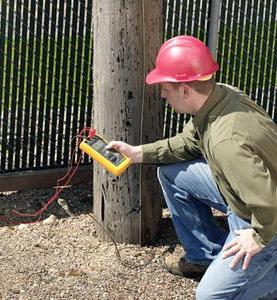Measurement of grounding
resistance is a mandatory requirement for the installation and operation of electrical appliances, provided for by the operating rules and the fire safety instructions.
There are several different methods for performing the measurement of grounding resistance, applied at the choice of a specialist, depending on several factors, such as the nature and conditions of the measurement, the values of the resistance to be measured, the relative accuracy and speed of measurements.
The measurement of grounding resistance is carried out to examine its condition. The process of taking measurements is carried out in several stages:
- The visible part of the grounding is examined, namely: the grounding loop is checked, the reliability of the connection of grounding devices to the electrical network. Carefully inspect the junction of wires and grounding parts. Cracks in the welds of the joints and loosening of the mounting bolts are not allowed, and the compliance of the inspected grounding with the installation rules is checked.
- Preparatory work for the measurement is being carried out. These include the creation of an artificial current circuit, for which no less than 40 meters from the grounding device an auxiliary ground electrode is installed, connected by a wire to the measuring device. The second electrode, called the potential, is installed similarly to the auxiliary one at least 20 meters, and is also connected to the measuring device using a wire.
- The final step is to measure the resistance of the grounding devices, for which the wire is connected to the measuring device and the ground electrode, and then the loop resistance is measured directly.

The measurement of grounding resistance is carried out using special devices that use the principle of potential drop created by alternating current between the electrodes, one of which is called potential, the second - auxiliary. Based on the results of measurements of the grounding device, a protocol is drawn up, on the basis of which a conclusion is made about its serviceability and admission of the electrical installation to operation.
It is noticed that only in dry weather with minimal air humidity the soils have the highest resistivity, and that is why it is recommended to use such weather conditions when planning the measurement of grounding resistance. Of course, such work is carried out in any weather and at different times of the year, for which there are normative seasonal coefficients that take into account the weather factor when calculating resistance. If we talk about the timing of them, it provides for annual checks of grounding resistance of electrical installations, and after repairs or reconstruction of the grounding.
Specialists who have undergone special training, who know how to check the grounding and have the appropriate approval for electrical safety, are involved in these works.